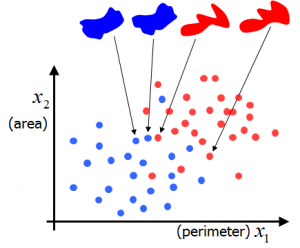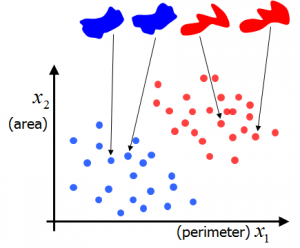The significance of a proper representation has been discussed here in several ways. The scene is now ready to make a significant step which is not often discussed in the pattern recognition literature. Let us first summarize the observations made so far.
Representation is the step in pattern recognition between real world objects or events and a space where objects can be related. A vector space is a good and popular example. Also models like strings and graphs can be used as long as it is possible to compute (dis)similarities between the representations of objects.
In a representation space densities and distances may be used for generalization. It makes it possible to relate new objects to the classes defined for a training set.
If the representation is constituted by a continuous mapping then similar objects are represented closely as in the above figure. It results to what is called a compact representation in pattern recognition. Such a representation is sufficient to guarantee some generalization, either by distances or by densities.
A problem is however that representations may reduce. Very different objects may be close in their representation if some aspects relevant for the difference of the real world objects are not taken into account, e.g. weight in the above example. This may be solved if a ‘true representation’ could be found, that is a representation for which holds that similar objects have close representions AND close representation refer to similar objects. See the figure for an illustration.
In case the real world objects are labeled unambiguously then objects assigned to different classes cannot be identical. They will be different. If a true representation could be found then also the representations of objects the belong to different classes will be different. Consequently such classes will not overlap. For the example this means that area and perimeter are the only relevant object properties. Objects for which these are the same should be identical.
Consequently, true representations are a way to construct separable classes.
Filed under: PR System • Representation


